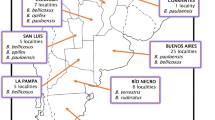Abstract
We studied the reproductive ecology of the bat fly Basilia nana on free-ranging colonial female and solitary male Bechstein’s bats (Myotis bechsteinii) during one reproductive season. The reproduction of B. nana took place from April to September, and the production of puparia in bat roosts was high. The metamorphosis of the flies took a minimum of 30 days, and at least 86% of the puparia metamorphosed successfully. However, only about 30% of flies from puparia deposited in female roosts and 57% of flies from puparia deposited in male roosts emerged in the presence of Bechstein’s bats and were thus able to survive. The significantly higher emergence success of bat flies in male roosts was caused by the higher roost fidelity of the solitary males compared with the social females. Our results indicate that bats can control the reproductive success of bat flies by switching and selecting roosts.



Similar content being viewed by others
References
Archer MS, Cardinal BR (2001) Seasonal reproduction and host infestation rates for Nycteribiids of the large bentwing bat. Med Vet Entomol 15:452–454
Bize P, Roulin A, Tella JL, Bersier JF, Richner H (2004) Additive effects of ectoparasites over reproductive attempts in the long-lived alpine swift. J Anim Ecol 73:1080–1088
Blanco G, De la Puente J, Corroto M, Baz T, Colas J (2001) Condition-dependent immune defence in the Magpie: how important is ectoparasitism. Biol J Linn Soc 72:279–286
Bowman AS, Coons LB, Needham GR, Sauer JR (1997) Tick saliva: recent advances and implications for vector competence. Med Vet Entomol 11(3):277–285
Clayton DH, Moore J (1997) Host–parasite evolution: general principles and Avian models. Oxford University Press, Oxford
Durden LA, Polur RN, Nims T, Banks CW, Oliver JH (2004) Ectoparasites and other epifaunistic arthropods of sympatric cotton mice and golden mice: comparisons and implications for vector-borne zoonotic diseases. J Parasitol 90(6):1293–1297
Fitze PS, Clobert J, Richner H (2004) Long-term life-history consequences of ectoparasite-modulated growth and development. Ecology 85 (7):2018–2026
Giorgi MS, Arlettaz R, Christe P, Vogel P (2001) The energetic grooming costs imposed by a parasitic mite (Spinturnix myoti) upon its bat host (Myotis myotis). Proc R Soc Lond B Biol Sci 268:2071–2075
Hase A (1931) Über die Lebensgewohnheiten einer Fledermausfliege in Venezuela; Basilia bellardii RONDANI (Fam Nycteribiidae–Diptera Pupipara). Z Parasitenkd 3:220–257
Hùrka K (1964) Distribution, bionomy and ecology of the European bat flies with special regard to the Czechoslovak fauna (Dip, Nycteribiidae). Acta Univ Carol Biol 1964(3):167–234
Kerth G (1998) Sozialverhalten und genetische Populationsstruktur bei der Bechsteinfledermaus (Myotis bechsteinii). Wissenschaft und Technik Verlag, Berlin
Kerth G, König B (1996) Transponder and an infrared-video camera as methods in a field study on the social behaviour of Bechstein’s bats (Myotis bechsteini). Myotis 34:27–34
Kerth G, König B (1999) Fission, fusion and nonrandom associations in female Bechstein’s bats (Myotis bechsteinii). Behaviour 136:1187–1202
Kerth G, Morf L (2004) Behavioural and genetic data suggest that Bechstein’s bats predominately mate outside the breeding habitat. Ethology 110(12):987–999
Kerth G, Reckardt R (2003) Information transfer about roosts in female Bechstein’s bats: an experimental field study. Proc R Soc Lond B Biol Sci 270:511–515
Kerth G, Mayer F, König B (2000) Mitochondrial DNA (mtDNA) reveals that female Bechstein’s bats live in closed societies. Mol Ecol 9:793–800
Kerth G, Safi K, König B (2002) Mean colony relatedness is a poor predictor of colony structure and female philopatry in the communally breeding Bechstein’s bat (Myotis bechsteinii). Behav Ecol Sociobiol 52:203–210
Leong MC, Marshall AG (1968) The breeding biology of the bat–fly Eucampsipoda sundaicum THEODOR, 1955 (Diptera: Nycteribiidae). Malay Nat J 21:171–180
Lewis SE (1995) Roost fidelity of bats—a review. J Mammal 76(2):481–496
Lewis SE (1996) Low roost-site fidelity in pallid bats: associated factors and effect on group stability. Behav Ecol Sociobiol 39:335–344
Lively CM (1996) Host–parasite coevolution and sex—do interactions between biological enemies maintain genetic variation and cross-fertilization? Bioscience 46(2):107–114
Löhrl H (1953) Fledermaus-Fliegen. Nat Volk 83:182–185
Marshall A (1970) The life cycle of Basilia hispida THEODOR 1967 (Diptera: Nycteribiidae) in Malaysia. Parasitology 61:1–18
Marshall AG (1971) The ecology of Basilia hispida (Diptera: Nycteribiidae) in Malaysia. J Anim Ecol 40:141–154
Marshall AG (1981) The ecology of ectorparasitic insects. Academic, London
Møller AP (1993) Ectoparasites increase the cost of reproduction in their hosts. J Anim Ecol 62:309–322
Ryberg O (1947) Studies on bats and bat parasites. Bokförlaget Svensk Natur, Stockholm, Sweden
Schulz H (1938) Über Fortpflanzung und Vorkommen von Fledermausfliegen (Fam. Nycteribiidae—Diptera, Pupipara). Z Parasitenkd 10:297–328
Theodor O (1954) Nycteribiidae. In: Lindner E (ed.) Die Fliegen der paläarktischen Region, vol 12. Stuttgart, Germany, pp 1–43
Theodor O (1967) An illustrated catalogue of the Rothschild collection of Nycteribiidae (Diptera) in the British Museum (Natural History). Britisch Museum (Natural History), London, United Kingdom, pp viii, 1–506
Van Valen L (1973) A new evolutionary law. Evol Theory 1:1–30
Waage JK (1979) The evolution of insect/vertebrate association. Biol J Linn Soc 12:187–224
Acknowledgements
We thank D. Dechmann, A. Ross-Gillespie, B. König and D. Turner for helpful comments on the manuscript. We are grateful to N. Bansac and S. Rauchfuss for their assistance in the field, to G. Lexa for leasing her apartment and to B. König for her constant support. The handling, marking and observation of Bechstein’s bats were done under license from the nature conservancy department of the government of Lower Frankonia. We gratefully acknowledge its support and that of the local department of forestry. This work was supported by the Swiss National Science Foundation (SNF; 31-59556.99).
Author information
Authors and Affiliations
Corresponding author
Rights and permissions
About this article
Cite this article
Reckardt, K., Kerth, G. The reproductive success of the parasitic bat fly Basilia nana (Diptera: Nycteribiidae) is affected by the low roost fidelity of its host, the Bechstein’s bat (Myotis bechsteinii). Parasitol Res 98, 237–243 (2006). https://doi.org/10.1007/s00436-005-0051-5
Received:
Accepted:
Published:
Issue Date:
DOI: https://doi.org/10.1007/s00436-005-0051-5




